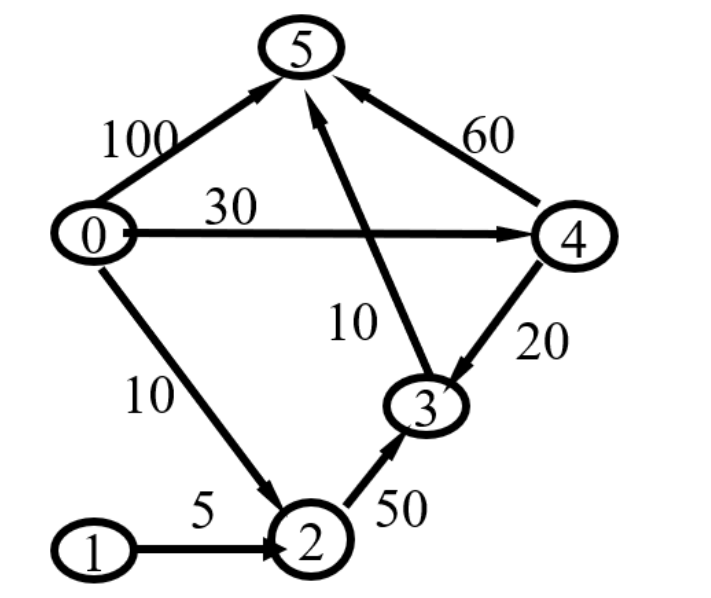最短路径(弗洛伊德算法)
试实现弗洛伊德最短路径算法。
一、函数接口定义:
void ShortestPath_Floyed(AMGraph G);
其中 G 是基于邻接矩阵存储表示的有向图。
二、裁判测试程序样例:
#include <iostream>
using namespace std;
#define MaxInt 32767
#define MVNum 100
typedef char VerTexType;
typedef int ArcType;
int Path[MVNum][MVNum];
int D[MVNum][MVNum];
typedef struct{
VerTexType vexs[MVNum];
ArcType arcs[MVNum][MVNum];
int vexnum,arcnum;
}AMGraph;
void CreateUDN(AMGraph &G);//实现细节隐藏
void ShortestPath_Floyed(AMGraph G);
void DisplayPath(AMGraph G , int begin ,int temp ){
if(Path[begin][temp] != -1){
DisplayPath(G , begin ,Path[begin][temp]);
cout << G.vexs[Path[begin][temp]] << "->";
}
}
int main(){
AMGraph G;
char start , destination;
int num_start , num_destination;
CreateUDN(G);
ShortestPath_Floyed(G);
cin >> start >> destination;
num_start = LocateVex(G , start);
num_destination = LocateVex(G , destination);
DisplayPath(G , num_start , num_destination);
cout << G.vexs[num_destination]<<endl;
cout << D[num_start][num_destination];
return 0;
}
/* 请在这里填写答案 */
三、输入样例:
第1行输入结点数vexnum和边数arcnum。第2行输入vexnum个字符表示结点的值,接下来依次输入arcnum行,每行输入3个值,前两个字符表示结点,后一个数表示两个结点之间边的权值。最后一行输入源点及终点。
6 8
012345
0 5 100
0 2 10
0 4 30
1 2 5
2 3 50
3 5 10
4 3 20
4 5 60
0 5
五、输出样例:
第一行输出源点到终点的最短路径,第二行输出源点到终点的最短路径距离。
0->4->3->5
60

#include <iostream>
#include <vector>
#include <limits>
using namespace std;
#define MaxInt numeric_limits<int>::max()
#define MVNum 100
typedef char VertexType;
typedef int ArcType;
int Path[MVNum][MVNum];
int D[MVNum][MVNum];
struct AMGraph {
VertexType vexs[MVNum];
ArcType arcs[MVNum][MVNum];
int vexnum, arcnum;
};
void CreateUDN(AMGraph& G) {
cout << "Enter the number of vertices (vexnum): ";
cin >> G.vexnum;
cout << "Enter the number of edges (arcnum): ";
cin >> G.arcnum;
cout << "Enter vertex value for each vertex: ";
for (int i = 0; i < G.vexnum; i++) {
cin >> G.vexs[i];
}
// Initialize the adjacency matrix
for (int i = 0; i < G.vexnum; i++) {
for (int j = 0; j < G.vexnum; j++) {
G.arcs[i][j] = MaxInt;
}
}
cout << "Enter arc value for each edge (start_vertex end_vertex arc_value): ";
for (int k = 0; k < G.arcnum; k++) {
char start, end;
int weight;
cin >> start >> end >> weight;
int i = 0;
while (G.vexs[i] != start) {
i++;
}
int j = 0;
while (G.vexs[j] != end) {
j++;
}
G.arcs[i][j] = weight;
G.arcs[j][i] = weight;
}
}
void ShortestPath_Floyd(AMGraph& G) {
int vexnum = G.vexnum;
// Initialize D and Path
for (int i = 0; i < vexnum; i++) {
for (int j = 0; j < vexnum; j++) {
D[i][j] = G.arcs[i][j];
if (D[i][j] != MaxInt && i != j) {
Path[i][j] = j; // 修改为j,表示直接到达j
} else {
Path[i][j] = -1;
}
}
}
for (int k = 0; k < vexnum; k++) {
for (int i = 0; i < vexnum; i++) {
for (int j = 0; j < vexnum; j++) {
if (D[i][k] != MaxInt && D[k][j] != MaxInt && D[i][k] + D[k][j] < D[i][j]) {
D[i][j] = D[i][k] + D[k][j];
Path[i][j] = Path[i][k]; // 修改为Path[i][k]
}
}
}
}
}
void DisplayPath(AMGraph G, int start, int end) {
if (Path[start][end] == -1) {
cout << "No path exists from " << G.vexs[start] << " to " << G.vexs[end] << endl;
return;
}
cout << "Shortest path from " << G.vexs[start] << " to " << G.vexs[end] << ": ";
cout << G.vexs[start];
int i = start;
while (i != end) {
i = Path[i][end];
cout << " -> " << G.vexs[i];
}
cout << endl;
}
int LocateVex(AMGraph G, char target) {
for (int i = 0; i < G.vexnum; i++) {
if (G.vexs[i] == target) {
return i;
}
}
return -1;
}
int main() {
AMGraph G;
CreateUDN(G);
ShortestPath_Floyd(G);
char source, destination;
cout << "Enter the source and destination vertices: ";
cin >> source >> destination;
int sourceIndex = LocateVex(G, source);
int destinationIndex = LocateVex(G, destination);
if (sourceIndex == -1 || destinationIndex == -1) {
cout << "Invalid source or destination vertex.\n";
} else {
DisplayPath(G, sourceIndex, destinationIndex);
cout << "Shortest distance: " << D[sourceIndex][destinationIndex] << endl;
}
return 0;
}



